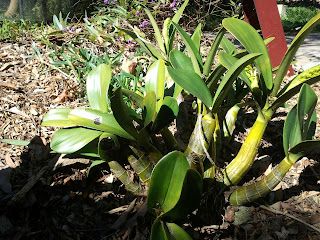I have never grown my own potatoes before, so when I was at my local nursery recently, the box of seed potatoes were calling me. I had to think whether I had a spot for them and I did, so I could not resist! I was really excited to plant my very first crop of potatoes.
I will update as to the progress of my potatoes but when planting them on Monday, the process seemed relatively straightforward. I know potatoes don't like too much water, as they can be susceptible to rot, so finally, after all this Sydney rain stopped, and the sun came out, I thought this the perfect time to get my planting underway.
As Peter Cundall states, seed potatoes are the best potatoes to plant in the garden because they are free of diseases and viruses that can affect tuber growth and production. You are more likely to achieve a bumper harvest by purchasing certified seed potatoes.
What do you need:
1. Potatoes...
(I chose sebago, as they are a good, all rounder potato, I have heard relatively hardy, I might splash out with some more interesting potato varieties if these go well)
2. A plot...
(I had originally used this bed for flowers, however, now the summer annuals are well and truly gone, I thought this would be perfect...lots of sun and holy moley...so many worms!)
3. Compost....beautiful, rich compost...full of worms.
 |
| I could not believe how many worms were contained in this load of compost...it was crazy! |
Potatoes can be grown in a number of ways, they can be grown in big gardens, small gardens and on patios and verandahs. However, as I have pretty good space in the city, I chose the simplest and probably old-fashioned way of growing them...In-ground production, where crops are grown in trenches and then hilled with soil.
Once you he purchased your seed potatoes, encourage potatoes to sprout prior to planting by exposing them to some light (not direct sunlight). The potatoes will start to develop small shoots (as they do when you leave them in the cupboard for too long). Once they have established some shoots, cut the potatoes up, so each section contains a shoot. For every average sized potato I had, I cut into halves and threes, making sure, each had an 'eye' or shoot. If a potato only had one shoot, than I didn't both cutting it.
I then prepared my plot. The soil I was planting into was already quite rich, I knew this because the soil was dark, moist and full of worms...some signs of pretty healthy soil. So I used some of the compost from my bin and forked it into the bed. You can also use some manure. I didn't have any, so stuck to the compost, raked up some leaves from around the garden and applied a little sprinkling of blood and bone.
I then dug my trenches...and placed the potato seeds into them. I planted them approximately 20cm apart and around 10cm deep.
After this, simply cover the potatoes with around 10cm of soil and water.I sprinkled some blood and bone over the top and watered it in. Right now, it just looks like some soil but hopefully in a few times I will have some exciting shoots!
* As the potato begins to emerge, cover them with soil, taken from either side of the trench. Repeat this process of 'hilling the crop' several times during the first four to six weeks of growth.
* Peter Cundall says that hilling potatoes with loose soil and compost allows the tubers can swell freely.Covering developing tubers protects them from sunlight, which turns them green.Hilling also provides them with excellent drainage and creates a form of irrigation.
* correct watering is vital during the first six to eight weeks of planting, as this is when the tuber develops. Don't over water but don't let them dry out, during winter, this means around every 2 to 3 days or so.
Right now is the perfect time to plant some potatoes. They are very easy and can also be grown in pots and containers.
Container potatoes:
*select a well draining pot, container, wheelbarrow, bathtub or hessian sack (make sure it is well draining, meaning the water can drain through the pot).
*mix 50/50 compost and some good quality potting mix, add some mulch or grass clippings to the mix.
*place about 10cm of the soil mix in the bottom of your container and lay potatoes, spaced, around 20cm apart (depending on the size of container). and cover with about 10cm of soil mix.
*as the shoots appear, continue to progressively cover with the compost/soil mix, until the container is full and then mulch well.
Harvesting:
I will know when to start harvesting my potatoes, by 'bandicooting', harvesting a few potatoes at a time while leaving the remainder to grow. I am told home-grown spuds can take up to 20 weeks to harvest, whilst commercial growers can usually harvest in around 12 weeks. So I am thinking if I planted them in mid-June, I will hopefully, start to get some crops by September/October. When foliage growth starts to die back, it means you are unlikely to get anymore tubers forming and they will be ready to harvest.
I am super duper excited.



















































